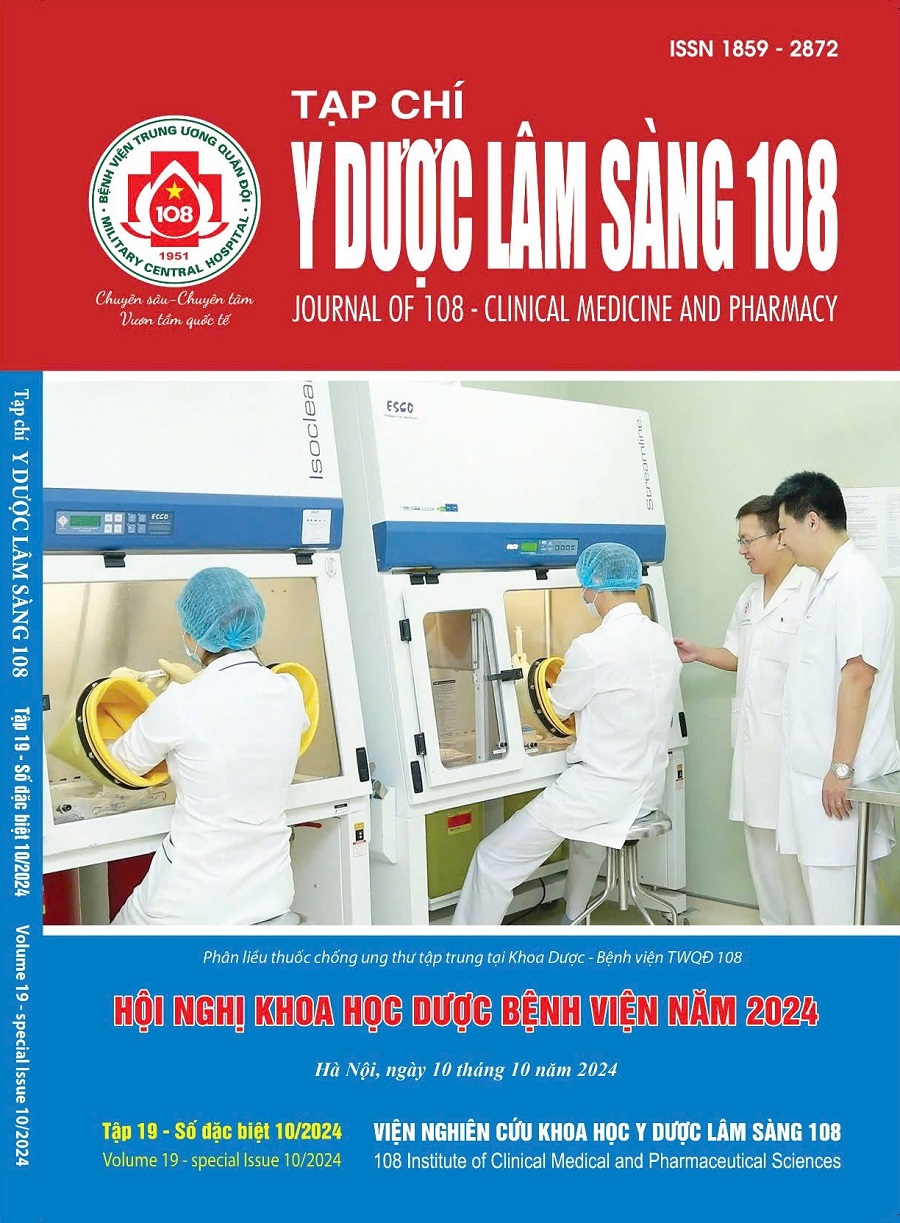A study on the efficacy of anticoagulant treatment with vitamin K antagonists in outpatients at 108 Military Central Hospital
Main Article Content
Keywords
Abstract
Objective: The study was conducted to investigate the status of INR control of vitamin K antagonists among outpatients. Subject and method: We conducted a retrospective cohort study of outpatients who were prescribed vitamin K antagonists (VKA) at 108 Military Central hospital from January 2023 to December 2023. The primary criteria was the quality of anticoagulant control, which was assessed using time-in-therapeutic range (TTR) using the Rosendaal method. Result: A total of 157 outpatients were enrolled in the study. The primary indication for VKA was non-valvular atrial fibrillation, accounting for 65%. During the follow-up period, 35% of patients were performed at least one INR measurement, and 30% of all the measurements achieved the therapeutic range. Regarding the INR range of 2.0-3.0, the mean TTR% was 32.9% and 21.7% of patients were classified as good anticoagulant control. For the INR range of 2.5-3.5, the mean TTR% and the percentage of patients with good VKA control were found to be 20.6% and 4.3%, respectively. Conclusion: The effectiveness of INR control of vitamin K antagonists in hospitals is suboptimal. Measures should be taken to enhance the quality control of VKA anticoagulant therapy in the facility.
Article Details
References
2. Kaatz S (2008) Determinants and measures of quality in oral anticoagulation therapy. Journal of thrombosis and thrombolysis 25(1): 61-66.
3. National Institute for Health and Care Excellence: Guidelines. Atrial fibrillation: Diagnosis and management. London: National Institute for Health and Care Excellence (NICE).
4. Hindricks G, Potpara T, Dagres N, Arbelo E, Bax JJ, Blomström-Lundqvist C et al (2021) 2020 ESC Guidelines for the diagnosis and management of atrial fibrillation developed in collaboration with the European Association for Cardio-Thoracic Surgery (EACTS): The Task Force for the diagnosis and management of atrial fibrillation of the European Society of Cardiology (ESC) Developed with the special contribution of the European Heart Rhythm Association (EHRA) of the ESC. Eur Heart J. 42(5):373-498.
5. Phong KĐ, Trí HHQ (2020) Đánh giá chất lượng của điều trị chống đông bằng thuố́c kháng Vitamin K ở bệnh nhân rung nhĩ không do bệnh van tim. Tạp chí Tim mạch học.
6. Thủy ĐTT (2016) Khảo sát hiệu quả điều trị của thuốc kháng Vitamin K trên bệnh nhân rung nhĩ hoặc có van tim cơ học tại bệnh viện Trưng Vương. Tạp chí Tim mạch học.
7. Kiều HT, Đỗ Văn Bửu Đan, Vinh PN (2015) Khảo sát thời gian INR trong khoảng điều trị của bệnh nhân đang điều trị thuốc kháng Vitamin K tại phòng khám BV Tâm Đức. Chuyên đề Tim mạch học.
8. Haas S, Ten Cate H, Accetta G, Angchaisuksiri P, Bassand JP, Camm AJ et al (2016) Quality of Vitamin K Antagonist Control and 1-Year Outcomes in Patients with Atrial Fibrillation: A Global Perspective from the GARFIELD-AF Registry. PLoS One 11(10): 0164076.
9. Rose A (2015) Anticoagulation management: Springer.
10. Rosendaal FR, Cannegieter SC, van der Meer FJ, Briet E (1993) A method to determine the optimal intensity of oral anticoagulant therapy. Thrombosis and haemostasis 69(3): 236-239.
11. De Caterina R, Husted S, Wallentin L, Andreotti F, Arnesen H, Bachmann F et al (2013) Vitamin K antagonists in heart disease: Current status and perspectives (Section III). Position paper of the ESC Working Group on Thrombosis -Task Force on Anticoagulants in Heart Disease. Thrombosis and haemostasis 110(6): 1087-1107.
12. Hội Tim mạch Việt Nam (2022) Khuyến cáo của Phân hội nhịp tim Việt Nam về chẩn đoán và xử trí rung nhĩ.
13. Geller AI, Shehab N, Lovegrove MC, Weidle NJ, Budnitz DS (2023) Bleeding related to oral anticoagulants: Trends in US emergency department visits, 2016-2020. Thrombosis research 225: 110-115.
14. Anticoagulant Forum (2019) Core Elements of Anticoagulation Stewardship Programs Administrative Oversight Gap Analysis: Hospitals and Skilled Nursing Facilities.
15. Chiang CE, Wang KL, Lip GY (2014) Stroke prevention in atrial fibrillation: An Asian perspective. Thrombosis and haemostasis 111(5): 789-997.
 ISSN: 1859 - 2872
ISSN: 1859 - 2872
